- Left hand
- Right hand
- Left foot
- Right foot
- Head
These are considered the five points of the outside of the body. Everything else is considered the inside of the body.
by Chen Zhonghua Taiji Academy on 2013/10/28
These are considered the five points of the outside of the body. Everything else is considered the inside of the body.
by Chen Zhonghua Taiji Academy on 2013/10/25
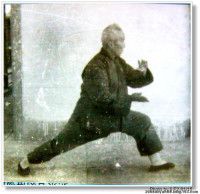 It is considered a good thing to hurt the muscles. Muscles are not afraid of pain. In the Practical Method system, we do not train the muscles. Train muscles means to bulk up the muscles to make them strong. We elongate muscles. This requires a different method of training.
It is considered a good thing to hurt the muscles. Muscles are not afraid of pain. In the Practical Method system, we do not train the muscles. Train muscles means to bulk up the muscles to make them strong. We elongate muscles. This requires a different method of training.
It is a bad thing to hurt ligaments and bones. Ligaments and bones are afraid of being shortened, not elongated. Postures should be large and low so as to allow the elongation of ligaments and the skeletal structure.
by Chen Zhonghua Taiji Academy on 2013/10/12
Iowa Workshop on October 12, 2013.
by moboting on 2013/07/12
My question is assuming that the kua(s) are opened does that result in neutral equalibrium because the center of gravity is neither raised or lowered, basically by allowing those to be at the same level at the same time then potential energy, rotation, and reveloution are possible because if something with neutral equilibrium moves those around with follow, and then using joint rotation, you are using angular velocity which then turns into linear velocity, almost like a series of rotations(angular velocity occur) starting from the bottom up then transmitted to linear velocity, therefore if you have these continous angular velocity it is like a wheel continuously spinning around the axis while taiji has numerous axis points that are rotating.
by Todd Elihu on 2013/05/17
In 2009 on Daqingshan, Master Chen Zhonghua instructed me to keep one point on my body stable and fixed during push hands practice. The location of the point was up to me; I could make it be the lower back, rear foot, etc. However, the most important thing was to maintain the integrity and stability of the chosen point. Read more
by Shopmaster on 2013/05/01
 Master Chen teaches a rule in Taiji movements that requires all actions to start from the Dantian and then ends in the Dantian.
Master Chen teaches a rule in Taiji movements that requires all actions to start from the Dantian and then ends in the Dantian.
Presenter: Chen Zhonghua Length: 3 min. In: English Year: 2013 Difficulty:1/5 At:Daqingshan
by Shopmaster on 2013/04/15

Private lesson for Jonathan Hormadaly, yilu correction, with demonstration of move application. Circle in push hand., internal circle.
Presenter: Chen Zhonghua Length: 81 min. In: English Year: 2012 Difficulty:4/5 At:Toronto, Canada
by Shopmaster on 2013/03/25
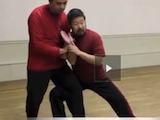
by Shopmaster on 2013/03/24
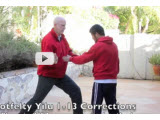
Detailed Yilu corrections and talks on practical method principle. Part of a series of one hour private lessons, Master Chen covered different areas of taiji for each student as other private student are watching.
Presenter: Chen Zhonghua Length: 95 min. In: English Year: 2012 Difficulty:1/5 At:Phoenix, USA.
by Shopmaster on 2013/03/15
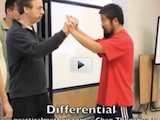
1. Chen Zhonghua demonstration: Yilu 3-13. 2. Practice. 3. Differential. 4. Energy transmission. 5. Connection spot. 6. Hollow chest. 7. Tipped Dang. 8. Error corrections. 9. 3-dimensional circle. 10. Taiji 3-Theory.
Presenter: Chen Zhonghua Length: 55 min. In: English Year: 2012 Difficulty:4/5 At:Toronto, Canada
by Chen Zhonghua Taiji Academy on 2013/03/06
At a higher level when the inside of the body is stretched out, the outside frames (structure) of the body should start to close. This is in compliance with the principle of “the energy must be released but structure remain intact”.
Here are some simple explanations of the structure and energy movements of the knee. Read more
by Shopmaster on 2013/03/05
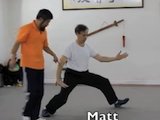
Yilu hands on corrections for 12 students at the 2012 September Toronto workshop. This is a good video to see common problems ranging from beginners to intermediate students. Length: 60 min. In: English Year: 2012 Difficulty:2/5
by Shopmaster on 2013/02/26
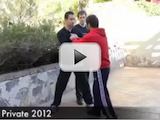
Presenter: Chen Zhonghua Length: 48 min. In: English Year: 2012 Difficulty:3/5 At:Phoenix, AZ. USA
by Shopmaster on 2013/02/08
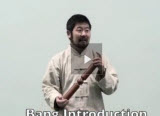 Presenter: Chen Zhonghua Length: 7 min. In: English Year: 2010 Difficulty:1/5 At:Edmonton
Presenter: Chen Zhonghua Length: 7 min. In: English Year: 2010 Difficulty:1/5 At:Edmonton
by Chen Zhonghua Taiji Academy on 2013/02/02
When you are stepping, which is a global move called revolution, you are free to move your knee.
Once you finish this move, in which case, you have landed your foot and fixed your foot as an anchor, your knee should also be fixed. Read more
by Shopmaster on 2013/02/01
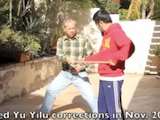
by Shopmaster on 2013/01/28
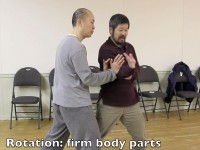 The key to taiji movements is first of all ROTATION. But how can we rotate when we have two feet, two legs, etc.? In this video, Master Chen Zhonghua shows one aspect of rotational movement requirements: the body must be firm to form a structure conducive to a rotation. Presenter: Chen Zhonghua Length: 12 min. In: English Year: 2013 Difficulty:4/5 At:Maple Ridge, B.C. Canada
The key to taiji movements is first of all ROTATION. But how can we rotate when we have two feet, two legs, etc.? In this video, Master Chen Zhonghua shows one aspect of rotational movement requirements: the body must be firm to form a structure conducive to a rotation. Presenter: Chen Zhonghua Length: 12 min. In: English Year: 2013 Difficulty:4/5 At:Maple Ridge, B.C. Canada
by Shopmaster on 2013/01/15
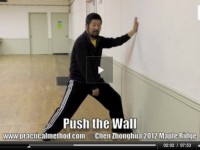 How to push the wall to create an arch in the body. This is a special exercise in the Chen Style Taijiquan Practical Method system. It is part of the construction of the new body structure to create an alignment of energy in the body. Presenter: Chen Zhonghua Length: 8 min. In: English Year: 2012 Difficulty:1/5 At:Maple Ridge, B.C. Canada
How to push the wall to create an arch in the body. This is a special exercise in the Chen Style Taijiquan Practical Method system. It is part of the construction of the new body structure to create an alignment of energy in the body. Presenter: Chen Zhonghua Length: 8 min. In: English Year: 2012 Difficulty:1/5 At:Maple Ridge, B.C. Canada
by Shopmaster on 2013/01/02

Second video added 1.Tile Hand 2.Wrist 3. Head – Inside and Outside, Rotation and Catch. Presenter: Chen Zhonghua Length: 25 min + 17 min. In: English Year: 2012 Difficulty:4/5 At:Maple Ridge, B.C. Canada
by Shopmaster on 2013/01/01
 Presenter: Chen Zhonghua Length: 16 min. In: English Year: 2012 Difficulty:1/5 At:Daqingshan, China
Presenter: Chen Zhonghua Length: 16 min. In: English Year: 2012 Difficulty:1/5 At:Daqingshan, China
by Shopmaster on 2012/12/20
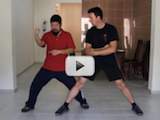
Presenter: Chen Zhonghua Length: 12 min. In: English Year: 2012 Difficulty:1/5 At:Singapore
by Ping Wei on 2012/12/11
In Practical Method, when we want to move foot forward, back, or side, we need to have the weight shift to the supporting leg and “pump” the other leg out. In other words, the leg which is moving out will not interfere the whole body balance. It’s independent from the rest of the body. It can move freely. The taiji terminology for this is “Chan Chu” (Shovel out). Read more
by webmaster2 on 2012/11/30
”Collapse” is when a movement causes the loss of the original structure.
This is a common mistake in the learning of Taijiquan. Read more
by webmaster2 on 2012/11/09
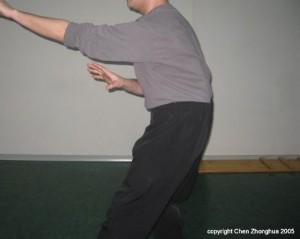 In many cases, when people move, they always render their kua too short in consideration of the opponent’s position. In the following photos, one shows that the kua is too short (the one that has an overall bent body) and one shows the correct kua.
In many cases, when people move, they always render their kua too short in consideration of the opponent’s position. In the following photos, one shows that the kua is too short (the one that has an overall bent body) and one shows the correct kua.
originally published 02/22/2008 Read more
by Jean-Philippe Ranger on 2012/10/18
Here is a short video that we filmed in my class last night. In the gym where I teach, we found an exercise device that can illustrate the importance of the alternating fixed point in the Practical Method. The explanation is not as precise as I would have wanted, but we filmed this on the spur of the moment.
by Nicholas Fung馮嘉傑(香港) on 2012/06/13
Shifu:
I am checking in with another question. Read more
by Chen Zhonghua Taiji Academy on 2012/05/13
“架子”是“拳架”一词的更口语,更随意的说法。练太极的都把“架子”挂在嘴边上。练套路叫“走架”,叫“盘架子”。师傅对生徒练的套路里的错误加以纠正,以及为提高生的套路水平而加以指点,都叫“拨架子”,因为“拨”字,含有“拨正”和“点拨”的意思。 Read more

Sorry no trailer
Two videos by Chen Zhonghua. One with Michael Koh on Daqingshan in May 2011. When we push hands or making moves, one of the most common problems is that the whole body (parts other than the part used) are engaged. In this video, Master Chen Zhonghua shows Michael Koh how to push with his hands without engaging his shoulders. As you can see in the video, this is not easy to do. Presenter: Chen Zhonghua Length: 2 min. In: English Year: 2011 Difficulty:3/5 At:Edmonton, Alberta, Canada. The second video is made in Edmonton in Jan. 2012. It is 5:45 long and covers the rotation and movement requirements of the shoulder. How the shoulder can rotate 360 degree. The last topic is on Zhuan Guan.
by Sun Zhonghua on 2012/04/06
The Wired article in Geekdad reviews the body structure and alignment required for drawing the bow.
 Quote: Now compare the grip; Hawkeye is gripping the bow mostly from the side; his fingers wrapped solidly around the handle, with his wrist off to the side in an attempt to get it out of the way, hence the first arm guard. By contrast, Brady’s hand is holding the bow very lightly, just a couple of fingertips resting on it. The bow is pressed against the base of his thumb, his palm is at a 45-degree angle, and his wrist bones point directly into the center of the bow. This makes for a lot less bow movement and a much more accurate shot. Read more
Quote: Now compare the grip; Hawkeye is gripping the bow mostly from the side; his fingers wrapped solidly around the handle, with his wrist off to the side in an attempt to get it out of the way, hence the first arm guard. By contrast, Brady’s hand is holding the bow very lightly, just a couple of fingertips resting on it. The bow is pressed against the base of his thumb, his palm is at a 45-degree angle, and his wrist bones point directly into the center of the bow. This makes for a lot less bow movement and a much more accurate shot. Read more
by ksloke on 2012/03/16
by Sun Zhonghua on 2012/02/09
在国内,打太极拳的随处可见;在国外也不罕见。如果您稍微留点儿心,就会发现,绝大多数人走架的时候,手的动作多、动作大而且繁复。推手时也如是,净看见两个人用手互相推拉撕扯了。 Read more
by Chen Zhonghua Taiji Academy on 2012/02/05
by Jean-Philippe Ranger on 2012/01/31
In the last few months, I have been trying to follow the rule of “elbow in, hand out”. In my practice and teaching I have observed something that needs further verification, but that seems correct. “Elbow in” means: initiate the arm rotation from the upper arm. Conversely, “hand out” means: initiate the arm rotation from the hand. There are a few possible explanations for this. First, I will say a few words about the “elbow in” part of rule, then I will suggest an explanation of the “hand out” part of the rule. Read more
by Sun Zhonghua on 2012/01/24
有道是“学拳容易改拳难”,与其学错了再改,不如一上手就学对的。练太极,尤其是在初期,要把自己的非太极动作改掉,改就是提高。 Read more
by admin on 2012/01/22
by admin on 2012/01/21
by Mat Beausoleil on 2012/01/18
 When the body becomes accustomed to moving through the forms in a connected way, the structure of the body will naturally begin to tighten up. As a result, the over exaggerated stretching movements previously used to open up and recondition the body should be adjusted and made smaller and tighter. Read more
When the body becomes accustomed to moving through the forms in a connected way, the structure of the body will naturally begin to tighten up. As a result, the over exaggerated stretching movements previously used to open up and recondition the body should be adjusted and made smaller and tighter. Read more
by Chen Zhonghua Taiji Academy on 2012/01/18
Twisting the towel is one of the basic foundation exercises of the Chen Style Taijiquan Practical Method system. it is also called the four-cardinal yin yang split.
by Jean-Philippe Ranger on 2012/01/15
